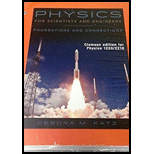
The reason that Foucault pendulum hits all the pegs in
Answer to Problem 1PQ
The Foucault pendulum hits all the pegs in
Explanation of Solution
The Foucault pendulum does oscillation in the Earth’s reference frame, which is continuously rotating about its axis. Earth make one complete rotation in
Pendulum is not going to change its plane of oscillation when it is placed in inertial frame. Therefore, it will hit only two opposite pegs.
Conclusion:
Therefore, Foucault pendulum hits all the pegs in
Want to see more full solutions like this?
Chapter 39 Solutions
Physics for Scientists and Engineers: Foundations and Connections
- (a) Find the value of for the following situation. An astronaut measures the length of his spaceship to be 100 m, while an observer measures it to be 25.0 m. (b) What is the of the spaceship relative to Earth?arrow_forwardAn experimentalist in a laboratory finds that a particle has a helical path. The position of this particle in the laboratory frame is given by r(t)=Rcost+Rsint+vztk where R, vz, and are constants. A moving frame has velocity (vM)L=vzk relative to the laboratory frame. a. What is the path of the particle in the moving frame? b. What is the velocity of the particle as a function of time relative to the moving frame? c. What is the acceleration of the particle in each frame? d. How should the acceleration in each frame be related? Does your answer to part (c) make sense? Explain.arrow_forwardA rod moving with a speed v along the horizontal direction is observed to have length and to make an angle with respect to the horizontal as shown in Figure P38.17. (a) Show that the length of the rod as measured by an observer at rest with respect to the rod is p = [1( v2/c2) cos2 ]1/2. (b) Show that the angle p that the rod makes with the x axis according to an observer at rest with respect to the rod can be found from tan p = tan . These results show that the rod is observed to be both contracted and rotated. (Take the lower end of the rod to be at the origin of the coordinate system in which the rod is at rest.)arrow_forward
- A starship is 1025 ly from the Earth when measured in the rest frame of the Earth. The ship travels at a speed of 0.80c on its way back to the Earth. What is the distance traveled as measured by the crew of the starship?arrow_forwardIn an attempt to produce exotic new particles, a proton of mass mp = 1.67 1027 kg is accelerated to 0.99c (c = 3.00 108 m/s is the speed of light) and crashed into a helium nucleus of mass mHe = 6.64 1027 kg initially at rest. The collision is elastic. a. What is the kinetic energy of the helium nucleus after the collision? b. What is the kinetic energy of the proton after the collision? (In Chapter 39, well learn what Einstein says about making such calculations.)arrow_forward(a) Show that tidal force on a small object of mass m, defined as the difference in the gravitational force that would be exerted on m at a distance at the near and the far side of the object, due to the gravitational at a distance R from M, is given by Ftidal=2GMmR3r where r is the distance between the near and far side and rR .(b) Assume you are fallijng feet first into the black hole at the center of our galaxy. It has mass of 4 million solar masses. What would be the difference between the force at your head and your feet at the Schwarzschild radius (event horizon)? Assume your feet and head each have mass 5.0 kg and are 2.0 m apart. Would you survive passing through the event horizon?arrow_forward
- (a) Using data from Potential Energy of a System (http://cnx.org/content/m5831211atest/#fs-id1165036086155) , find the mass destroyed when the energy in a barrel of crude oil is released. (b) Given these barrels contain 2(N) liters and assuming the density of crude oil is 750kg/m3, what is the ratio of mass destroyed to original mass, m/m?arrow_forwardMuch of the mass of our Milky Way galaxy is concentrated in a central sphere of radius r = 2 kpc, where pc is the abbreviation for the unit parsec; 1 pc = 3.26 ly. Assume the Sun is in a circular orbit of radius r = 8.0 kpc around the central sphere of the Milky Way. The Suns orbital speed is approximately 220 km/s; assume the central sphere is at rest. a. Estimate the mass in the inner Milky Way. Report your answer in kilograms and in solar masses. b. What is the escape speed of the Milky Way? c. CHECK and THINK: Do you believe that stars in the Milky Way have been observed to have speeds of 500 km/s? Explain.arrow_forward
 Physics for Scientists and Engineers: Foundations...PhysicsISBN:9781133939146Author:Katz, Debora M.Publisher:Cengage Learning
Physics for Scientists and Engineers: Foundations...PhysicsISBN:9781133939146Author:Katz, Debora M.Publisher:Cengage Learning Principles of Physics: A Calculus-Based TextPhysicsISBN:9781133104261Author:Raymond A. Serway, John W. JewettPublisher:Cengage Learning
Principles of Physics: A Calculus-Based TextPhysicsISBN:9781133104261Author:Raymond A. Serway, John W. JewettPublisher:Cengage Learning University Physics Volume 3PhysicsISBN:9781938168185Author:William Moebs, Jeff SannyPublisher:OpenStax
University Physics Volume 3PhysicsISBN:9781938168185Author:William Moebs, Jeff SannyPublisher:OpenStax University Physics Volume 1PhysicsISBN:9781938168277Author:William Moebs, Samuel J. Ling, Jeff SannyPublisher:OpenStax - Rice University
University Physics Volume 1PhysicsISBN:9781938168277Author:William Moebs, Samuel J. Ling, Jeff SannyPublisher:OpenStax - Rice University Physics for Scientists and EngineersPhysicsISBN:9781337553278Author:Raymond A. Serway, John W. JewettPublisher:Cengage Learning
Physics for Scientists and EngineersPhysicsISBN:9781337553278Author:Raymond A. Serway, John W. JewettPublisher:Cengage Learning Physics for Scientists and Engineers with Modern ...PhysicsISBN:9781337553292Author:Raymond A. Serway, John W. JewettPublisher:Cengage Learning
Physics for Scientists and Engineers with Modern ...PhysicsISBN:9781337553292Author:Raymond A. Serway, John W. JewettPublisher:Cengage Learning





